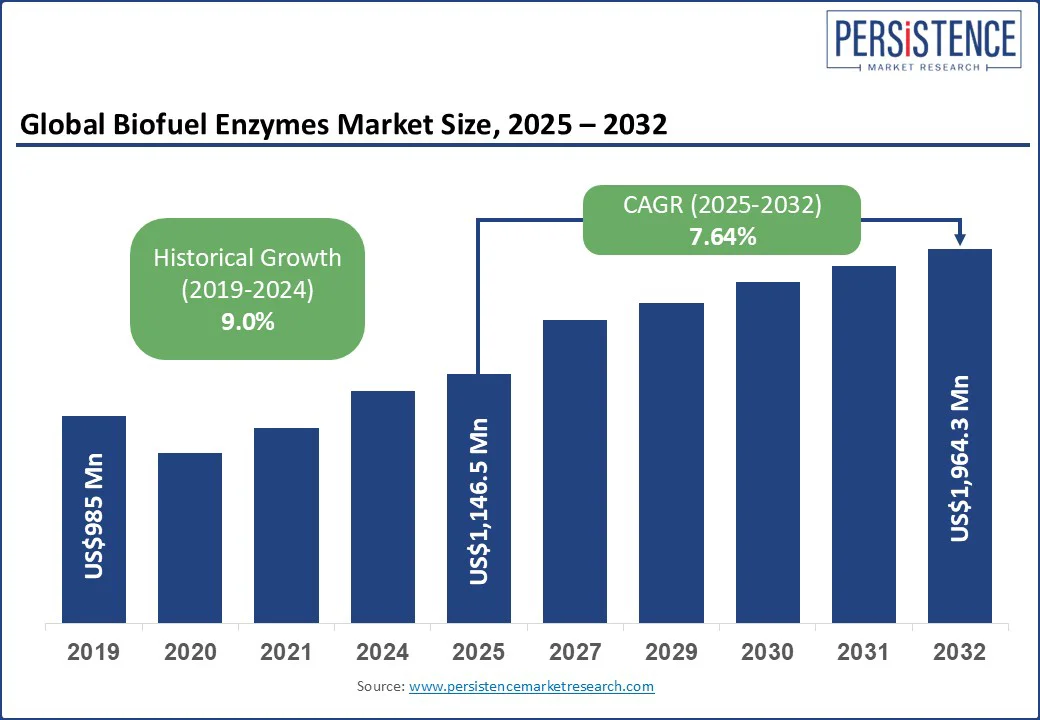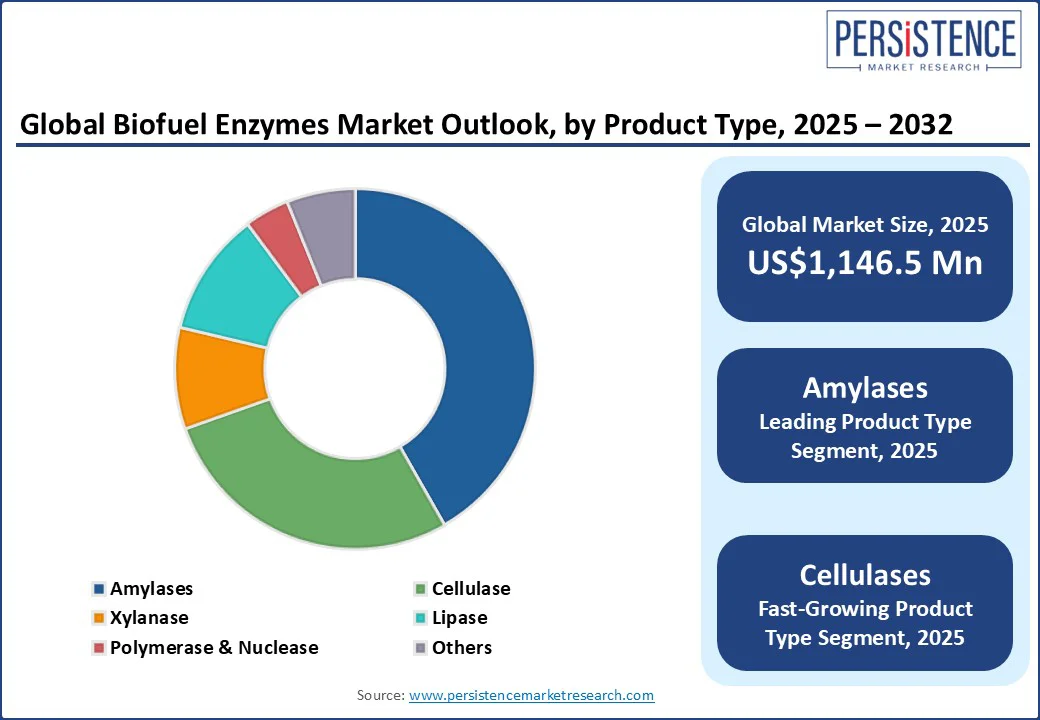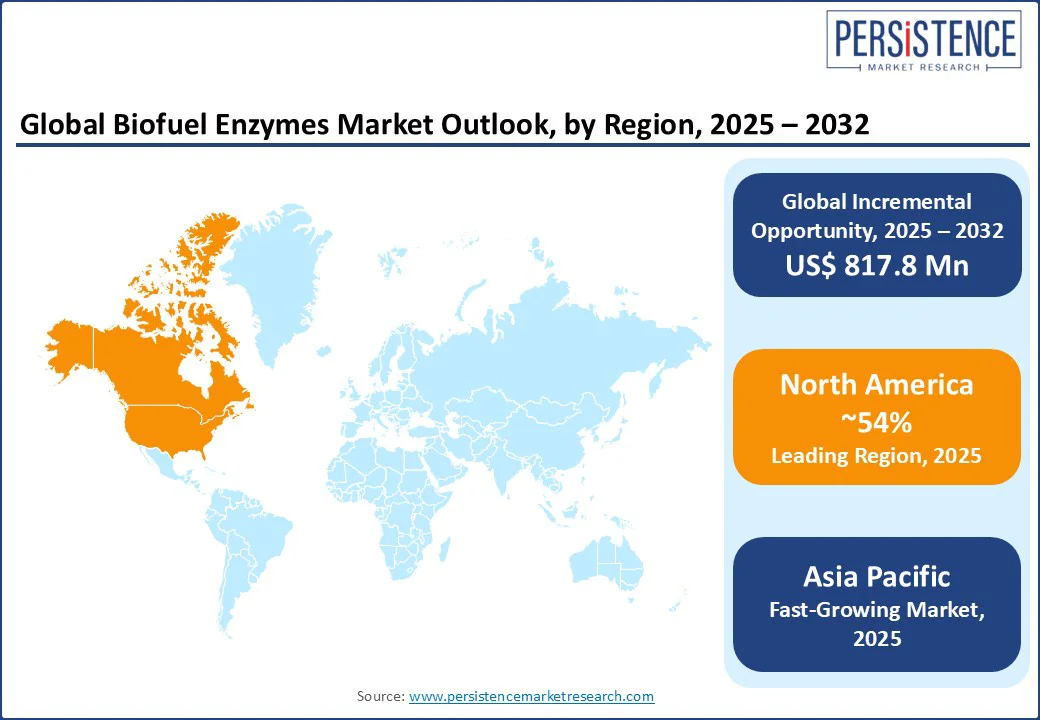ID: PMRREP35581| 186 Pages | 26 Aug 2025 | Format: PDF, Excel, PPT* | Chemicals and Materials

The global biofuel enzymes market size is likely to be valued at US$1,146.5 Mn in 2025 to US$1,964.3 Mn by 2032, growing at a CAGR of 7.64% during the forecast period from 2025 to 2032.
Clinical research on enzyme immobilization for stability, genetic engineering for feedstock flexibility, and government-backed incentives, especially in developing regions with expanding biofuel mandates, drives growth.
Biofuel enzymes such as cellulases and lipases are eco-friendly biocatalysts, which break down complex biomass into sugars and lipids for conversion into renewable fuels, including ethanol and biodiesel. This process enables energy-efficient production with minimal toxic byproducts.
The rising global demand is fueled by the shift toward low-carbon economies, stricter emission regulations, technological advances in enzyme engineering, and the growing use of lignocellulosic biomass and enzymatic biodiesel processes, which reduce costs and environmental impact.
Key Industry Highlights:

|
Global Market Attribute |
Key Insights |
|
Biofuel Enzymes Market Size (2025E) |
US$ 1,146.5 Mn |
|
Market Value Forecast (2032F) |
US$ 1,964.3 Mn |
|
Projected Growth (CAGR 2025 to 2032) |
7.64% |
|
Historical Market Growth (CAGR 2019 to 2024) |
9.0% |
A key growth driver in the biofuel enzymes market is the rapid progress in genetic engineering technologies, which enhance enzyme feedstock flexibility and improve the overall process efficiency.
As biofuel producers increasingly shift to non-food, lignocellulosic biomass, such as agricultural residues, the demand for genetically engineered enzymes capable of efficiently hydrolyzing diverse and recalcitrant substrates has surged. For instance, Novozymes and DSM have yielded enzyme variants with enhanced thermostability and tolerance to harsh industrial conditions, enabling continuous processing and higher biofuel yields at reduced operational costs.
Shift toward genetically optimized cellulases and hemicellulases not only unlocks cost-competitive second-generation (2G) biofuels but also mitigates the risk of feedstock scarcity by tapping into abundant low-value residues globally.
Moreover, this factor synergizes with growing regulatory mandates targeting lifecycle carbon reduction as these engineered enzymes enable cleaner biofuel pathways with up to 70% lower emissions compared to conventional fossil fuels, as per the International Energy Agency (IEA).
The strategic integration of genetic engineering has thus proven to be a transformative force in expanding the scope of application of biofuel enzymes, setting the stage for scalable, sustainable biofuel production that meets both economic and environmental compulsions.
A key hindering factor is the persistently high production costs, coupled with challenges in enzyme stability under industrial conditions, both of which continue to limit large-scale commercial adoption. Despite technological progress, the cost of producing specialized biofuel enzymes, such as cellulases and lipases engineered for lignocellulosic biomass conversion, remains substantially higher than conventional chemical catalysts, often accounting for up to 40% of total biofuel production expenses.
This cost barrier is further exacerbated by the risks of enzyme deactivation due to thermal and pH instability during prolonged processing, necessitating frequent replenishment that drives up operational costs and complicates process scalability.
For example, pilot plants in Southeast Asia reported a 15% yield drop linked to enzyme degradation when processing high-ash agricultural residues, according to a 2024 analysis published in the Asia Bioenergy Journal. Furthermore, supply chain constraints in sourcing raw materials for enzyme biosynthesis and delays in affordable enzyme formulations customized for diverse regional feedstock add significant complexity, slowing market penetration in developing economies.
The biofuel enzymes market growth is driven by a surging demand for renewable transportation fuels, strict environmental regulations, and the shift from fossil fuels to sustainable alternatives. Enzymatic biodiesel production using advanced enzyme cocktails to process diverse feedstocks such as waste cooking oils represents one of the most lucrative avenues, delivering higher yields, lower costs, and sustainability.
Innovations such as Fermbox Bio’s 2024 EN3ZYME, designed to maximize sugar release from lignocellulosic biomass, drive the development of second-generation biofuels. Breakthroughs in enzyme immobilization and genetic engineering, which enhance stability, expand feedstock flexibility, and enable scalability, are further fueling these advancements.
Supported by government biofuel mandates and the push for circular economy models, biofuel enzymes are set to play a pivotal role in cost-competitive, eco-friendly biodiesel production, creating exciting opportunities for both enzyme technology developers and biofuel manufacturers.
Amylases dominate the product segment and is likely to command an estimated 41.2% revenue share in 2025, owing to their efficiency in converting starch-rich feedstock such as corn and wheat into ethanol.
This segment benefits from well-established and well-functioning agricultural supply chains across major bioethanol-producing countries, primarily the U.S. and Brazil, alongside robust government mandates such as the U.S. Renewable Fuel Standard that sustains a consistent demand level for ethanol-blended fuels. Innovations in amylase enzyme formulations and immobilization techniques are further enhancing process efficiency, reducing costs, and enabling the use of varied starch sources.
In contrast, cellulases are expected to register the highest CAGR through 2032, propelled by their essential role in breaking down lignocellulosic biomass, such as corn stover, wheat straw, and energy crops, into fermentable sugars for sustainable second-generation biofuels.
Rising environmental concerns over first-generation biofuels and stricter carbon regulations are facilitating this shift, aided by breakthroughs in enzyme engineering that improve cellulase stability, specificity, and synergistic action. Cutting-edge blends, such as Fermbox Bio’s 2024 EN3ZYME, have helped optimize sugar yields and process scalability.
Free enzyme catalysis is anticipated to lead the technology segment with an approximate share of 51% in 2025, owing to its widespread adoption and operational simplicity. This technology offers flexibility and an ease of integration that make it ideal for large-scale starch-based ethanol and biodiesel production, especially in established biofuel-producing regions such as Brazil.
Free enzymes enable rapid catalytic action with relatively low upfront investment, supporting a variety of feedstock from corn to waste oils. However, their limited stability and single-use nature have pushed continuous enzyme engineering efforts to boost their catalytic efficiency and thermal tolerance.
Immobilized enzyme systems comprise the fastest-growing technology, supported by an increasing demand for enzyme reusability, stability, and cost efficiency in next-generation biofuel production. By anchoring enzymes onto solid supports or matrices, immobilized systems enable repeated use, considerably reducing enzyme costs and improving process scalability. Advances in immobilization materials, such as nanoparticles and novel polymers, have further strengthened enzyme activity retention and durability under harsh industrial conditions.
For example, a 2023 biotech innovation achieved a 30% cost reduction and 20% higher biodiesel yields using immobilized lipase for waste cooking oil. This technology is proving instrumental in advancing consolidated bioprocessing and continuous-flow reactors.

North America is expected to hold a leading position in 2025, capturing nearly 54% of the biofuel enzymes market share. The regional market is driven by strong government backing for bio-based fuel alternatives through subsidies, tax incentives, and stringent biofuel blending mandates such as the U.S. Renewable Fuel Standard (RFS). These regulatory frameworks have ensured a steady demand for enzymes, particularly amylases for starch-based ethanol and lipases for biodiesel.
Abundant agricultural production in the U.S. and Canada, rich in corn and other starch crops, provides a reliable and cost-effective feedstock supply. Moreover, North America is a hub for cutting-edge enzyme engineering and biotech innovations, with companies such as Fermbox Bio pioneering advancements in catalytic efficiency and scalability.
Significant investments in biotech R&D have promoted the adoption of enzyme immobilization and advanced enzyme blends, enhancing production yields while lowering costs. The market growth here aligns closely with the sustainability initiatives implemented across the U.S. and Canada, environmental regulations aimed at cutting greenhouse gas emissions, and the broader transition toward renewable energy.
Asia Pacific is anticipated to be the fastest-growing market for biofuel enzymes, driven by expanding biofuel production capacity in key countries such as China and India, along with increasing collaborations between global enzyme developers and regional and local biotech companies. Skyrocketing energy demand and a deepening emphasis on sustainability amid pollution challenges have prompted governments to implement renewable energy targets and formulate supportive biofuel policies.
The region’s abundant and highly diversified feedstock base, covering agricultural residues, sugarcane bagasse, switchgrass, and waste cooking oils, has boosted the demand for enzymes such as lipases for biodiesel production. Besides these factors, biofuel producers in the Asia Pacific are leveraging cost-effective enzyme production methods, including on-site manufacturing, reducing bio-refinery expenses.
Although Europe accounts for small share of approximately 13% in the global biofuel enzymes market, it presents strong growth opportunities driven by stringent environmental regulations and sustainability-focused policies, such as the European Union’s Green Deal.
This framework prioritizes second-generation biofuels, increasing the demand for cellulases and advanced enzyme formulations that support eco-friendly biofuel production. Innovation hubs in Germany, France, and the U.K. are leading the development of next-gen enzyme technologies, emphasizing immobilization techniques and consolidated bioprocessing to boost efficiency and cut costs.
Strong public and private investments in R&D activities are driving improvements in enzyme thermal stability and substrate specificity. Further supporting this growth is the EU’s strong commitment to circular economy principles, which is driving the conversion of waste and residues into biofuels reducing reliance on food crops and enhancing environmental sustainability.

The global biofuel enzymes market is driven by advances in enzyme engineering, strategic alliances, and a strong emphasis on sustainability-focused innovation among the top biotech companies. Advances in genetically modified enzymes are enhancing catalytic efficiency and thermal stability, improving biofuel yields while lowering production costs, especially for lignocellulosic biomass in the second-generation biofuel sector.
Mergers and partnerships between enzyme manufacturers and biofuel producers are broadening product portfolios and expanding market access worldwide. Competitive advantage now hinges on adopting enzyme immobilization and continuous-flow micro-reactor technologies, which boost scalability and cost-effectiveness. Key market players are also diversifying feedstock compatibility to include waste oils and agricultural residues, aligning with circular economy goals and tightening regulations.
The biofuel enzymes market is projected to reach US$ 1,146.5 Mn in 2025.
The shift toward low-carbon economies, stricter emission regulations, and technological advances in enzyme engineering drives the market.
The biofuel enzymes market is poised to witness a CAGR of 7.64% from 2025 to 2032.
A surging demand for renewable transportation fuels and the transition from fossil fuels to sustainable alternatives are the key opportunities.
Novozymes A/S, DuPont de Nemours, Inc., and Koninklijke DSM N.V. are some of the leading players.
|
Report Attribute |
Details |
|
Historical Data/Actuals |
2019 - 2024 |
|
Forecast Period |
2025 - 2032 |
|
Market Analysis |
Value: US$ Bn |
|
Geographical Coverage |
|
|
Segmental Coverage |
|
|
Competitive Analysis |
|
|
Report Highlights |
|
|
Customization and Pricing |
Available upon request |
By Product Type
By Feedstock
By Application
By Technology
By Region
Delivery Timelines
For more information on this report and its delivery timelines please get in touch with our sales team.
About Author